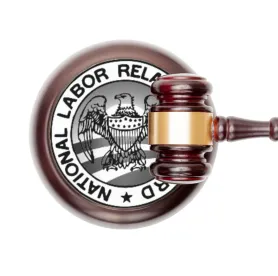-
The National Labor Relations Board (NLRB) announced on Dec. 10 that it will again revisit its joint employer standard.
The agency’s 2022 regulatory agenda includes plans to engage in the formal rulemaking process on the standard in February. The NLRB’s joint employer analysis has significant implications for employers, as it determines when one entity jointly employs another firm’s workers. Among other results, a joint employer finding makes both entities liable for each other’s unfair labor practices. Joint employment has been one of the most controversial topics in labor law in recent years. The Obama-era NLRB reversed decades of precedent in its 2015 Browning-Ferris Industries decision, finding joint employment status even where one of the entities exercised only indirect control over another’s employees or had the unexercised right of control over such employees. 362 NLRB 1599 (2015). After unsuccessfully attempting to restore the pre-Browning-Ferris standard through case adjudication, the Trump-era NLRB issued a formal rule in 2020, setting the current employer-friendly standard. Under that standard, an entity must have direct and immediate control over employee terms and conditions of work to be considered a joint employer (NLRB Rules and Regulations, §103.40). Given the Democratic majority on the current NLRB, it is likely that it will restore the Browning-Ferris standard or issue a similar rule.
-
On Dec. 27, the NLRB solicited public input on its analysis of independent contractor status under the National Labor Relations Act (NLRA). The Atlanta Opera, Inc., 371 NLRB No. 45 (2021).
In a notice issued in an ongoing representation case, the NLRA invited interested parties to submit briefs on whether the agency should “reconsider its standard for determining the independent contractor status of workers.” This issue is highly significant. Independent contractors are not “employees” under the NLRA and are excluded from the law’s coverage. Independent contractors do not have Section 7 rights to engage in protected concerted activity and, therefore, do not have the right to unionize. For many years, the NLRB applied an employer-friendly common law agency test to determine whether a worker is an employee or independent contractor. In FedEx Home Delivery, 361 NLRB 610 (2014), the Obama-era NLRB amended that standard by emphasizing the extent to which purported independent contractors had actual “entrepreneurial opportunity” and by adding a requirement that the putative contractor operate as an “independent” business. This analysis greatly increases the likelihood of “employee” status. In 2019, in SuperShuttle DFW, Inc., 367 NLRB No. 75, the Trump-era NLRB overruled FedEx and returned to the traditional prior standard. The NLRB’s Atlanta Opera notice asks the following questions:
(1) Should the Board adhere to its traditional independent contractor standard?
(2) If not, what should the standard be? Should the Board return to FedEx Home Delivery either in its entirety or with modifications?
Given the Democratic majority on the current NLRB, it likely will either return to FedEx or set a similarly employee-friendly standard. Briefs are due to the Board on Feb. 10, 2022, and parties may file responsive briefs by Feb. 25, 2022.
-
The NLRB has invited briefs on whether it should reconsider its standard for determining if a petitioned-for bargaining unit should be expanded.
In American Steel Construction, 371 NLRB No. 41 (Dec. 7, 2021), the NLRB invited interested parties to file briefs as to whether the Board should return to its bargaining unit analysis in Specialty Healthcare and Rehabilitation Center, 357 NLRB 934 (2011). Specialty Healthcare was widely criticized for enabling so-called microunits, which facilitated union organizing. At issue is the analysis used to determine the composition of a bargaining unit. An appropriate unit is comprised of a group of employees who share a “community of interest.” The Obama-era Board’s Specialty Healthcare decision added a major hurdle: employers seeking to expand the union’s proposed bargaining unit had to establish that the additional employees shared an “overwhelming community of interest” with the group proposed by the union. This proved to be a virtually insurmountable challenge for employers and allowed unions to choose units in which it had a greater likelihood of success. In PCC Structurals, Inc. 365 NLRB No. 160 (2017), the Trump-era Board reversed Specialty Healthcare, reverting to the traditional community of interest standard. The current NLRB asks for input as to whether it should adhere to PCC Structurals, Inc., return to the standard in Specialty Healthcare, or adopt another standard. Briefs were due on or before Jan. 21, 2022, and parties may file responsive briefs on or before Feb. 7.
-
In a Dec. 30 decision, applying U.S. Supreme Court precedent, the NLRB endorsed the legality of NLRB General Counsel (GC) Jennifer Abruzzo’s appointment and former GC Peter Robb’s ouster. Aakash d/b/a Park Central Care and Rehabilitation Center, 371 NLRB No. 46 (Dec. 30, 2021).
The issue arose in an unfair labor practice case alleging the employer refused to bargain with the union representing its employees. The employer argued in part that GC Abruzzo lacked the authority to pursue the case. The employer’s argument arose from President Joe Biden’s controversial Inauguration Day firing of former GC Robb, which the employer argued exceeded the president’s authority, thereby rendering unlawful Abruzzo’s subsequent appointment (and thus, the unfair labor practice complaint issued by the GC against the employer would have been null). Prior to the NLRB issuing its decision, the U.S. Supreme Court decided Collins v. Yellen, in which it ruled that: (1) a federal agency’s officer can be removed by the president except where federal law says otherwise; and (2) Congress acts intentionally when it writes a restriction in one part of a statute but not another. No. 19-563 (July 28, 2021). Applying Collins to the former GC’s removal, the NLRB held that, because the NLRA did not specifically limit the president’s authority to fire Robb, there was no basis under the NLRA to challenge his firing. Therefore, the ouster was lawful, as was Abruzzo’s subsequent appointment.
-
The U.S. Department of Labor (DOL) formally rescinded a Trump-era DOL rule concerning union finances.
Under a 2020 regulation, union trusts like apprenticeship programs and strike funds were subjected to stricter reporting requirements. Such requirements include mandatory disclosure of receipts of funds diverted to such trusts and the disposition of those funds. The Biden-era DOL stopped enforcement of the rule in March 2021 (before the deadline for the first union filings) and signaled that it intended to reverse the rule, which unions and the Administration criticized as onerous. Proponents of the rule argue that it increases transparency and curbs union corruption. On Dec. 29, the DOL released an announcement formally rescinding the 2020 rule.
Thomas V. Walsh and Megann K. McManus also contributed to this article.








 />i
/>i

